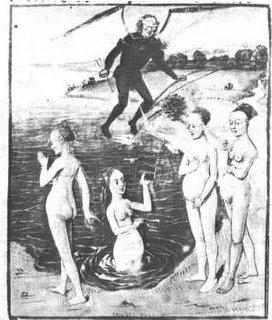skip to main |
skip to sidebar
“The Most Mysterious Manuscript In The World”
 In 1912 an American antique book dealer came upon an odd 235 page manuscript, it has come to be known as “the most mysterious manuscript in the world”. Let's take a closer look into this wild mystery...
In 1912 an American antique book dealer came upon an odd 235 page manuscript, it has come to be known as “the most mysterious manuscript in the world”. Let's take a closer look into this wild mystery...
Today we call the manuscript, the Voynich manuscript, it is named after its above mentioned discoverer, Wilfrid M. Voynich, who found it amongst a collection of ancient manuscripts kept in villa Mondragone in Frascati, near Rome, Italy, which had by then been turned into a Jesuit College (The school closed in 1953).
The mysterious work was illustrated with multicolored drawing and was handwritten in an unknown alphabet. Apparently, Voynich wanted to have the mysterious manuscript deciphered and provided photographic copies to a number of experts. However, despite the efforts of many well known cryptologists and scholars, the book remained unread.
Then in 1921 a professor of philosophy at the University of Pennsylvania named William Romaine Newbold announced that he had successfully deciphered the language. Newbold claimed that manuscript was the work of a thirteen century Franciscan friar and inventor named Roger Bacon. The translation indicated that Bacon had built and used microscopes and telescopes four hundred years prior to any other human being. Newbold didn't publish a great deal, and the story is that he soon went mad, many suspect it was as a result of his obsession with the Voynich manuscript that drove him over the edge. Soon after his death his diligent transcript was disapproved by leading authorities, although no one else came up with a more substantial theory.There are some other claims of decipherment, but to date, none of these others can be substantiated with a completed translation. So no one knows the origins of the manuscript. Based on the drawings, some experts believe it to be European, they also believe it to have been written between the 15th and 17th centuries.
The manuscript is small, seven by ten inches, but thick, nearly 235 pages. The illustrations in the work are strange, but much stranger is the text itself, because the manuscript is written entirely in a mysterious, unknown alphabet of which no other example is known to exist. It is an alphabetic script, yes, but of an alphabet variously  reckoned to have from nineteen to twenty-eight letters, none of which bear any relationship to any English or European lettering system.
reckoned to have from nineteen to twenty-eight letters, none of which bear any relationship to any English or European lettering system.
Eventually the book was bought by H. P. Kraus (a New York book antiquarian) in 1961 for the sum of $24,500. He later valued it at $160,000 but was unable to find a buyer. Finally he donated it to the Yale University Beinecke Rare Book Library in 1969. They then catalogued it as number MS 408. And so the manuscript found its way to Yale University – where it remains to this day, still “the most mysterious manuscript in the world”!
I'm Average Joe
 In 1912 an American antique book dealer came upon an odd 235 page manuscript, it has come to be known as “the most mysterious manuscript in the world”. Let's take a closer look into this wild mystery...
In 1912 an American antique book dealer came upon an odd 235 page manuscript, it has come to be known as “the most mysterious manuscript in the world”. Let's take a closer look into this wild mystery...
 reckoned to have from nineteen to twenty-eight letters, none of which bear any relationship to any English or European lettering system.
reckoned to have from nineteen to twenty-eight letters, none of which bear any relationship to any English or European lettering system. 

1 comment:
Good post and this mail helped me alot in my college assignement. Say thank you you seeking your information.
Post a Comment